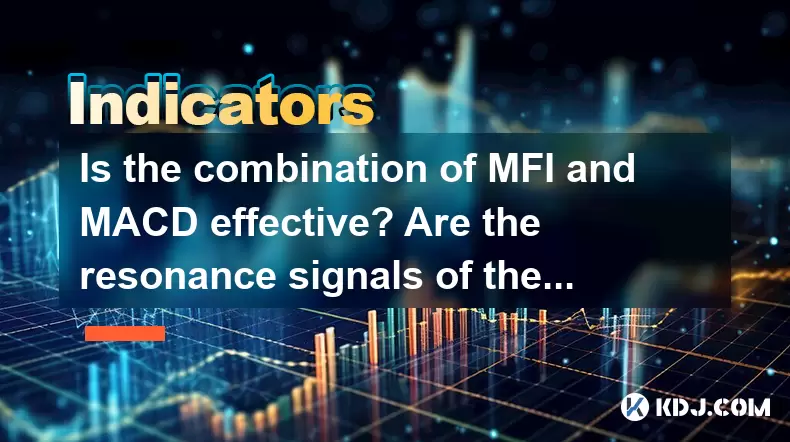-
 bitcoin
bitcoin $112195.049338 USD
2.42% -
 ethereum
ethereum $4124.915858 USD
2.81% -
 tether
tether $1.000570 USD
0.02% -
 xrp
xrp $2.861568 USD
2.25% -
 bnb
bnb $1000.346670 USD
3.04% -
 solana
solana $209.070819 USD
3.38% -
 usd-coin
usd-coin $0.999870 USD
0.02% -
 dogecoin
dogecoin $0.235379 USD
2.65% -
 tron
tron $0.335681 USD
-0.20% -
 cardano
cardano $0.803501 USD
3.38% -
 hyperliquid
hyperliquid $47.120881 USD
3.56% -
 chainlink
chainlink $21.501300 USD
3.44% -
 ethena-usde
ethena-usde $1.000571 USD
0.02% -
 avalanche
avalanche $29.793378 USD
3.62% -
 stellar
stellar $0.366964 USD
2.42%
Is the combination of MFI and MACD effective? Are the resonance signals of the two more reliable?
Combining MFI and MACD can enhance trading signal reliability in crypto markets, but effectiveness varies with market conditions and chosen cryptocurrency.
May 22, 2025 at 08:29 pm

The combination of the Money Flow Index (MFI) and the Moving Average Convergence Divergence (MACD) is a popular strategy among cryptocurrency traders seeking to enhance the reliability of their trading signals. This article delves into the effectiveness of using these two indicators together and whether the resonance signals they produce are more reliable than using either indicator alone.
Understanding MFI and MACD
The Money Flow Index (MFI) is a momentum indicator that measures the inflow and outflow of money into a security over a specific period. It is often used to identify overbought or oversold conditions in the market. The MFI ranges between 0 and 100, with readings above 80 indicating overbought conditions and readings below 20 suggesting oversold conditions.
The Moving Average Convergence Divergence (MACD) is a trend-following momentum indicator that shows the relationship between two moving averages of a security’s price. The MACD is calculated by subtracting the 26-period Exponential Moving Average (EMA) from the 12-period EMA. The result of this calculation is the MACD line. A 9-period EMA of the MACD, called the 'signal line,' is then plotted on top of the MACD line, which can function as a trigger for buy and sell signals.
Combining MFI and MACD
When traders combine MFI and MACD, they are looking to leverage the strengths of both indicators to generate more robust trading signals. The MFI can help identify potential reversals by highlighting overbought or oversold conditions, while the MACD can confirm these signals by indicating the strength and direction of the trend.
Identifying Resonance Signals
Resonance signals occur when both the MFI and MACD provide congruent signals. For instance, a resonance buy signal might be generated when the MFI moves out of the oversold zone (above 20) and the MACD line crosses above the signal line. Conversely, a resonance sell signal could be triggered when the MFI moves out of the overbought zone (below 80) and the MACD line crosses below the signal line.
Practical Application of MFI and MACD
To apply MFI and MACD effectively, traders can follow these steps:
- Select a Trading Platform: Choose a reliable trading platform that supports technical analysis tools. Many platforms offer customizable charts where you can add both MFI and MACD indicators.
- Set Up the Indicators: On the chart, add the MFI with a default period of 14 and the MACD with standard settings (12, 26, 9).
- Monitor the Indicators: Keep an eye on the MFI and MACD readings. Look for instances where the MFI moves above 20 or below 80, and simultaneously observe the MACD line crossing the signal line.
- Identify Resonance Signals: When both indicators align, consider entering a trade. For example, if the MFI rises above 20 while the MACD line crosses above the signal line, it might be a good time to buy.
- Set Stop-Loss and Take-Profit Levels: Always set appropriate stop-loss and take-profit levels to manage risk and lock in profits.
Evaluating the Effectiveness
The effectiveness of combining MFI and MACD can vary depending on market conditions and the specific cryptocurrency being traded. In volatile markets, the combination can help filter out false signals and provide more reliable entry and exit points. However, in sideways markets, the signals might be less effective as both indicators could generate frequent false positives.
Case Studies and Examples
To illustrate the potential effectiveness of this strategy, consider the following examples:
- Example 1: During a bullish trend in Bitcoin, the MFI drops to 18, indicating an oversold condition. Simultaneously, the MACD line crosses above the signal line. This resonance signal suggests a potential buying opportunity, and indeed, Bitcoin's price rises significantly over the next few days.
- Example 2: In a bearish trend for Ethereum, the MFI climbs to 82, signaling an overbought condition. At the same time, the MACD line crosses below the signal line. This resonance signal indicates a potential selling opportunity, and Ethereum's price subsequently declines.
Limitations and Considerations
While the combination of MFI and MACD can be powerful, it is not foolproof. False signals can still occur, especially in choppy or range-bound markets. Additionally, lagging nature of these indicators means they might not always capture rapid price movements in highly volatile cryptocurrencies.
Enhancing the Strategy
To enhance the strategy, traders can consider the following:
- Incorporate Additional Indicators: Adding other indicators, such as the Relative Strength Index (RSI) or Bollinger Bands, can provide further confirmation of trends and reversals.
- Use Different Timeframes: Analyzing the same signals across different timeframes (e.g., daily and hourly charts) can help confirm the strength and validity of resonance signals.
- Backtesting: Conduct thorough backtesting of the MFI and MACD strategy on historical data to understand its performance under various market conditions.
FAQs
Q: Can MFI and MACD be used effectively for all cryptocurrencies?A: While MFI and MACD can be applied to any cryptocurrency, their effectiveness can vary. More liquid and widely traded cryptocurrencies like Bitcoin and Ethereum tend to produce more reliable signals due to higher trading volumes and less manipulation.
Q: How often should I check the MFI and MACD indicators?A: The frequency of checking these indicators depends on your trading style. Day traders might monitor them multiple times a day, while swing traders could check them less frequently, perhaps once or twice a day.
Q: Are there any specific settings for MFI and MACD that work best for crypto trading?A: The default settings for MFI (14 periods) and MACD (12, 26, 9) are commonly used and generally effective. However, some traders might adjust these settings based on their trading strategy and the specific cryptocurrency's volatility.
Q: Can MFI and MACD be used for both short-term and long-term trading?A: Yes, both indicators can be used for short-term and long-term trading. For short-term trading, you might use shorter timeframes like 15-minute or hourly charts. For long-term trading, daily or weekly charts would be more appropriate.
Disclaimer:info@kdj.com
The information provided is not trading advice. kdj.com does not assume any responsibility for any investments made based on the information provided in this article. Cryptocurrencies are highly volatile and it is highly recommended that you invest with caution after thorough research!
If you believe that the content used on this website infringes your copyright, please contact us immediately (info@kdj.com) and we will delete it promptly.
- Solana: Institutions' Growing Confidence Signals a Bullish Future
- 2025-09-29 17:05:16
- PumpFun (PUMP) Price in October: Will the Memecoin Momentum Continue?
- 2025-09-29 16:25:14
- Cloud Mining, High-Yield Contracts, and Market Volatility: A New Yorker's Take
- 2025-09-29 17:05:16
- Royal Mint Error Coins: What's the Sell Price?
- 2025-09-29 16:25:14
- BABY Token Inflation and Co-Staking: A New Era for Babylon
- 2025-09-29 17:10:01
- Dogecoin, ETFs, and Memecoins: Navigating the Hype in the Wild World of Crypto
- 2025-09-29 17:10:01
Related knowledge

What is a tower bottom candlestick pattern? Does it have a high success rate?
Sep 22,2025 at 07:18am
Tower Bottom Candlestick Pattern Explained1. The tower bottom candlestick pattern is a reversal formation that typically appears at the end of a downt...

What is a black hole pattern in the MACD indicator? Is it a cause for concern?
Sep 21,2025 at 06:54pm
Bitcoin's Role in Decentralized Finance1. Bitcoin remains the cornerstone of decentralized finance, serving as a benchmark for value and security acro...

How can I use the psychological line (PSY) to determine market sentiment?
Sep 17,2025 at 02:19pm
Understanding the Psychological Line (PSY) in Cryptocurrency TradingThe Psychological Line, commonly referred to as PSY, is a momentum oscillator used...

How can I determine if a double top pattern has officially formed?
Sep 21,2025 at 03:18am
Understanding the Structure of a Double Top Pattern1. A double top pattern consists of two distinct peaks that reach approximately the same price leve...

What is the Golden Valley pattern on the moving average? Is it better than the Silver Valley pattern?
Sep 21,2025 at 02:54pm
Understanding the Golden Valley Pattern in Moving Averages1. The Golden Valley pattern is a technical formation observed in cryptocurrency price chart...

What does a death cross of the RSI in the strong zone (above 50) mean?
Sep 17,2025 at 10:54pm
Understanding the Death Cross in RSI Context1. The term 'death cross' is traditionally associated with moving averages, where a short-term average cro...

What is a tower bottom candlestick pattern? Does it have a high success rate?
Sep 22,2025 at 07:18am
Tower Bottom Candlestick Pattern Explained1. The tower bottom candlestick pattern is a reversal formation that typically appears at the end of a downt...

What is a black hole pattern in the MACD indicator? Is it a cause for concern?
Sep 21,2025 at 06:54pm
Bitcoin's Role in Decentralized Finance1. Bitcoin remains the cornerstone of decentralized finance, serving as a benchmark for value and security acro...

How can I use the psychological line (PSY) to determine market sentiment?
Sep 17,2025 at 02:19pm
Understanding the Psychological Line (PSY) in Cryptocurrency TradingThe Psychological Line, commonly referred to as PSY, is a momentum oscillator used...

How can I determine if a double top pattern has officially formed?
Sep 21,2025 at 03:18am
Understanding the Structure of a Double Top Pattern1. A double top pattern consists of two distinct peaks that reach approximately the same price leve...

What is the Golden Valley pattern on the moving average? Is it better than the Silver Valley pattern?
Sep 21,2025 at 02:54pm
Understanding the Golden Valley Pattern in Moving Averages1. The Golden Valley pattern is a technical formation observed in cryptocurrency price chart...

What does a death cross of the RSI in the strong zone (above 50) mean?
Sep 17,2025 at 10:54pm
Understanding the Death Cross in RSI Context1. The term 'death cross' is traditionally associated with moving averages, where a short-term average cro...
See all articles










































































